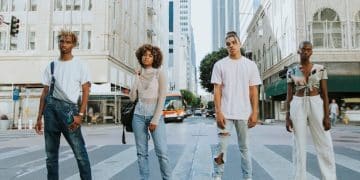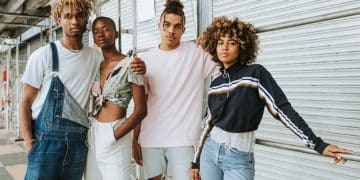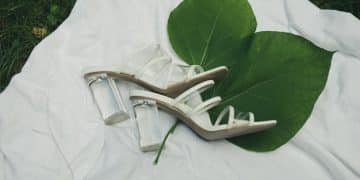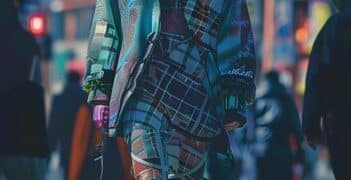Urban Style Guide: Sustainable Fashion Choices in 2025
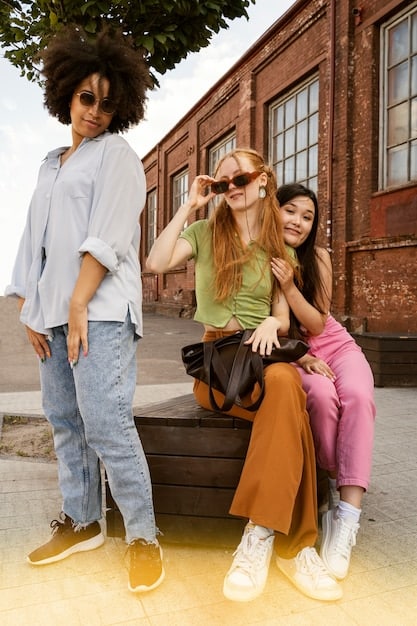
The Urban Style Guide: Sustainable Fashion Choices That Make a Statement in 2025 emphasizes eco-friendly materials, ethical production, and timeless designs to create a stylish and responsible urban wardrobe.
Step into the future of fashion with our Urban Style Guide: Sustainable Fashion Choices That Make a Statement in 2025. Discover how to blend style and sustainability effortlessly.
The Rise of Sustainable Urban Fashion
Sustainable fashion is no longer a niche trend; it’s a growing movement transforming urban style. In 2025, conscious consumers are prioritizing ethical and environmentally friendly clothing options. This shift is driven by increased awareness of the fashion industry’s impact and a desire for more responsible choices.
Let’s explore how this trend is reshaping urban landscapes.
Consumer Awareness and Demand
Consumers are becoming more educated about the environmental and social costs of fast fashion. They are actively seeking brands that prioritize transparency, fair labor practices, and sustainable materials. This demand is driving the growth of eco-friendly fashion brands and initiatives.
Technological Innovations in Sustainable Materials
Innovation plays a crucial role in advancing sustainable fashion. New technologies are enabling the creation of eco-friendly materials like recycled fabrics, plant-based leather alternatives, and biodegradable textiles. These innovations are expanding the possibilities for sustainable urban style.

Here are a few key areas where sustainable practices are making an impact:
- Eco-Friendly Materials: Look for clothing made from organic cotton, recycled polyester, and innovative materials like Tencel and bamboo.
- Ethical Production: Support brands that prioritize fair labor practices and safe working conditions throughout their supply chain.
- Circular Fashion: Embrace practices like clothing swaps, secondhand shopping, and upcycling to extend the life cycle of your wardrobe.
The rise of sustainable urban fashion reflects a broader cultural shift towards conscious consumption and environmental stewardship.
Key Elements of a Sustainable Urban Wardrobe
Building a sustainable urban wardrobe involves selecting versatile, eco-friendly pieces that can be mixed and matched for various occasions. The focus is on quality over quantity, choosing items that are durable, timeless, and ethically produced. This approach ensures that your wardrobe is both stylish and sustainable.
Let’s break down the essential components.
Versatile Basics and Capsule Wardrobes
A capsule wardrobe consists of a small selection of essential clothing items that can be combined to create a variety of outfits. This approach reduces consumption and ensures that each piece in your wardrobe is well-utilized. Opt for neutral colors and classic styles that can be easily dressed up or down.
Eco-Friendly Outerwear and Accessories
Outerwear and accessories are key elements of any urban wardrobe. Look for coats, jackets, and bags made from recycled materials, organic cotton, or innovative plant-based alternatives. Choose accessories that are ethically produced and designed to last.
Consider these options:
- Recycled Coats and Jackets: Stay warm and stylish with outerwear made from recycled materials like plastic bottles and fishing nets.
- Organic Cotton Bags: Carry your essentials in an eco-friendly tote bag or backpack made from organic cotton.
- Ethically Produced Jewelry: Add a touch of sparkle with jewelry made from recycled metals and ethically sourced gemstones.
Creating a sustainable urban wardrobe is about making thoughtful choices that reflect your values and minimize your environmental impact.
Top Sustainable Fashion Brands to Watch in 2025
As sustainable fashion gains momentum, numerous brands are emerging as leaders in ethical and eco-friendly practices. These brands are committed to transparency, fair labor, and innovative materials, offering consumers stylish and responsible clothing options. Staying informed about these brands can help you make conscious purchasing decisions.
Here are a few brands making waves.
Pioneers in Ethical Production and Transparency
Some brands have built their reputation on ethical production and transparency, ensuring that their supply chains are fair and environmentally responsible. These brands often provide detailed information about their manufacturing processes and material sourcing.
Innovative Use of Sustainable Materials
Other brands are focusing on innovation, creating clothing from groundbreaking sustainable materials. These materials include recycled fabrics, plant-based alternatives, and lab-grown textiles that reduce the environmental impact of fashion.
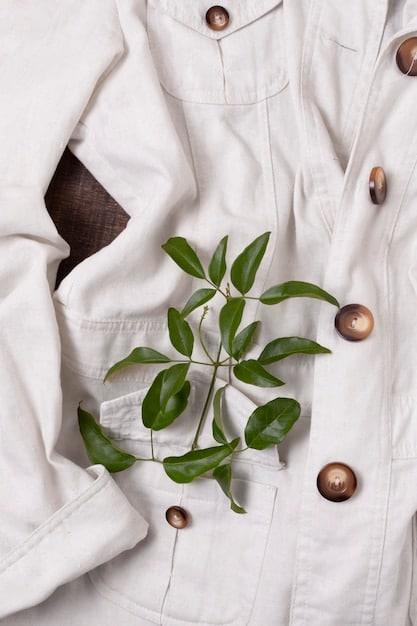
Consider supporting these brands:
- Stella McCartney: A pioneer in sustainable luxury fashion, Stella McCartney uses organic cotton, recycled materials, and innovative alternatives to leather and fur.
- Eileen Fisher: Known for its timeless designs and commitment to sustainability, Eileen Fisher uses organic cotton and recycled materials in its collections and offers a Renew program to recycle used clothing.
- Patagonia: An outdoor apparel company with a strong focus on environmental responsibility, Patagonia uses recycled materials and supports environmental activism through its 1% for the Planet initiative.
By supporting these brands, you can contribute to a more sustainable and ethical fashion industry.
DIY and Upcycling: Creative Ways to Embrace Sustainability
DIY and upcycling offer creative and hands-on ways to embrace sustainable fashion. These approaches allow you to transform old or unwanted clothing into new and unique pieces, reducing waste and expressing your personal style. Engaging in DIY and upcycling can be both fun and environmentally rewarding.
Let’s explore the possibilities.
Transforming Old Clothes into New Trends
Upcycling involves repurposing old clothing items into new and trendy designs. This can involve simple alterations like hemming pants or adding embellishments to create entirely new garments from existing materials. The possibilities are endless.
Accessing Online Tutorials and Workshops
Numerous online tutorials and workshops provide step-by-step instructions for DIY fashion projects. These resources cater to all skill levels, from beginners to experienced sewers, offering guidance on everything from basic alterations to advanced upcycling techniques.
Here’s how to get started:
- Find Inspiration: Browse online platforms like Pinterest and Instagram for upcycling ideas and DIY fashion tutorials.
- Gather Materials: Collect old clothing items, fabric scraps, and embellishments to create your upcycling projects.
- Learn Basic Sewing Skills: Familiarize yourself with basic sewing techniques like threading a needle, sewing a straight line, and attaching buttons.
DIY and upcycling are empowering ways to reduce waste, unleash your creativity, and create a unique sustainable urban wardrobe.
The Role of Technology in Promoting Sustainable Fashion
Technology plays a crucial role in promoting sustainable fashion, offering innovative tools and platforms to track environmental impact, connect consumers with ethical brands, and facilitate circular fashion practices. These technologies are empowering consumers to make informed choices and driving the adoption of sustainable practices across the industry. Embracing these technological advancements can significantly enhance your sustainable fashion journey.
Let’s examine the key developments.
Supply Chain Tracking and Transparency
Blockchain technology is being used to track the supply chain of clothing items, providing consumers with detailed information about the origin of materials, manufacturing processes, and labor conditions. This transparency enables consumers to make informed purchasing decisions based on ethical and environmental considerations.
Virtual Try-On and Sustainable Shopping Apps
Virtual try-on technologies allow consumers to try on clothing items virtually, reducing the need for returns and minimizing the environmental impact of shipping. Sustainable shopping apps provide curated lists of ethical brands and products, making it easier for consumers to discover responsible fashion options.
Consider these technological solutions:
- Good On You: A mobile app that rates fashion brands based on their environmental impact, labor practices, and animal welfare policies.
- Reflaunt: A platform that enables brands to integrate resale into their e-commerce sites, facilitating circular fashion practices.
- ThredUp: An online consignment store that offers a convenient way to buy and sell secondhand clothing.
Technology is revolutionizing the sustainable fashion landscape, providing consumers with the tools and information they need to make conscious purchasing decisions.
Future Trends: Sustainable Fashion in 2025 and Beyond
As we look ahead to 2025 and beyond, sustainable fashion is poised to become even more integrated into mainstream urban style. Emerging trends include personalized sustainability metrics, advanced recycling technologies, and collaborative consumption models. Staying informed about these trends can help you navigate the evolving landscape of sustainable fashion.
What can we expect in the coming years?
| Key Point | Brief Description |
|---|---|
| ♻️ Eco-Friendly Fabrics | Using materials like organic cotton and recycled polyester. |
| 🤝 Ethical Production | Supporting fair labor practices and safe working conditions. |
| 🔄 Circular Fashion | Embracing clothing swaps and secondhand shopping. |
| 📱 Tech Integration | Using apps for supply chain tracking and virtual try-ons. |
FAQ
▼
Sustainable clothing often utilizes organic cotton, recycled polyester, and innovative options like Tencel. These materials reduce water usage and minimize chemical pollution, fostering a more eco-friendly production cycle.
▼
Look for certifications like Fair Trade or B Corp, which indicate a brand’s commitment to ethical practices. Additionally, check for supply chain transparency and fair labor policies to ensure responsible sourcing.
▼
Circular fashion aims to extend the life cycle of clothing through practices like resale, upcycling, and recycling. Participate by buying secondhand, swapping clothes with friends, or creatively repurposing old garments.
▼
Technology enables supply chain tracking, virtual try-ons, and sustainable shopping apps. This fosters transparency and informed purchasing decisions, driving sustainability across the fashion industry.
▼
Future trends include personalized sustainability metrics, advanced recycling technologies, and collaborative consumption models. These innovations will further integrate sustainability into mainstream urban style.
Conclusion
Embracing the Urban Style Guide: Sustainable Fashion Choices That Make a Statement in 2025 is more than just a fashion statement; it’s a commitment to a better future. By prioritizing eco-friendly materials, ethical production, and innovative practices, you can create a stylish and responsible urban wardrobe that reflects your values.
